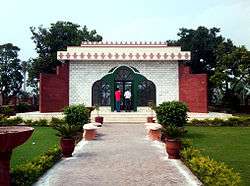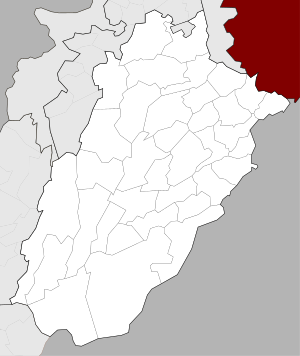Wazirabad
| Wazirabad وزِيرآباد | |
|---|---|
| City | |
 Tomb of Mulana Zafar Ali Khan | |
 Wazirabad Location of Wazirabad  Wazirabad Wazirabad (Pakistan) | |
| Coordinates: 32°26′7″N 74°6′51″E / 32.43528°N 74.11417°ECoordinates: 32°26′7″N 74°6′51″E / 32.43528°N 74.11417°E | |
| Country | Pakistan |
| Region | Punjab |
| District | Gujranwala District |
| Tehsil | Wazirabad Tehsil |
| No. of Union Councils | 5 |
| Municipal status | 1867 |
| Elevation | 215 m (705 ft) |
| Time zone | UTC+5 (PST) |
| • Summer (DST) | UTC+6 (PDT) |
Wazirabad (Urdu/Punjabi: وزِيرآباد) is an industrial city located in Gujranwala District, Punjab, Pakistan. It is also known as city of cutlery. As it is a popular place for production of cutlery items.
Wazirabad is situated on the banks of the Chenab River nearly 100 kilometres north of Lahore on the Grand Trunk Road. It is 45 kilometres from Sialkot, 30 kilometres from the district capital - Gujranwala and about 12 kilometres from Gujrat. The city of Wazirabad is the headquarters of Wazirabad Tehsil, an administrative subdivision of the district, the city is itself subdivided into 5 Union Councils.[1]
History
The town was first take over by Charat Singh around 1760 together with other towns in the District.[2] Maharja Ranjit Singh occupied the town in 1809 and Avitabile was appointed as the Nazim of the city. He built an entirely new town, with a straight broad bazar running through it, and side streets at right angles.[2]
British rule
During British rule Wazirabad was the headquarters of the old Wazirabad District, broken up in 1851-2, and was the site of a cantonment removed to Sialkot in 1855.
The municipality was created in 1867, the population according to the 1901 census was 18,069. The income during the ten years ending 1902-3 averaged Rs. 20,800, and the expenditure Rs. 21,400. In 1903-4 the income was Rs. 20,800, chiefly from octroi; and the expenditure was Rs. 19,200. The town had a considerable trade in timber, which comes down the Chenab from Jammu territory.[2] The smiths of Wazirabad had a reputation for the manufacture of small articles of cutlery, and the village of Nizamabad within a mile of the town is famed for its weapons. Wazirabad was an important junction on the North-Western Railway, as the Sialkot-Jammu and Lyallpur lines both branch off of here.[3]
The Chenab river is spanned opposite Wazirabad by the Alexandra railway bridge, one of the finest engineering works of the kind in India, which was opened by in 1876 by Edward VII the King-Emperor when he was Prince of Wales. The town possessed two Anglo-vernacular high schools, one maintained by the Church of Scotland Mission, and a Government dispensary.[3]
Educational Institutes
- Aspire College
- Chenab College of IT & Commerce
- Punjab Group of Colleges
- Superior Group of Colleges
- Youth Academy
- Youth Group of Schools and Colleges
- Youth Institute of Technology
Notable residents
- Atif Aslam, singer
- Shaikh Nazrul Bakar, civil servant
- Munnu Bhai, writer
- Razia Butt, writer
- Krishan Chander, writer
- Hamid Nasir Chattha, former Speaker of the National Assembly of Pakistan
- Zafar Ali Khan, writer, poet, and journalist
- Hafiz Mushtaq Ahmad Kokab, writer, Scholar, and Journalist (Writer of Tareekh-e-Wazirabad)
- Jawwad S. Khawaja, 23rd Chief Justice of Pakistan
- Shaista Nuzhat, poet, writer, columnist and bureaucrat
- Mohammad Abdul Ghafoor Hazarvi: Muslim theologian, orator and revivalist leader
- Mazhar ul Islam, writer
- Muhammad Shareef ud Din, Sufi and orator
- S. A. Rahman, fifth Chief Justice of Pakistan
References
Further reading
| Wikivoyage has a travel guide for Wazirabad. |
- Bailey, Thomas Grahame (1904). Panjabi Grammar: A Brief Grammar of Panjabi As Spoken in the Wazirabad District (in English and Punjabi). Lahore, Pakistan: Punjab Government Press / World Digital Library. Retrieved 2013-05-23.